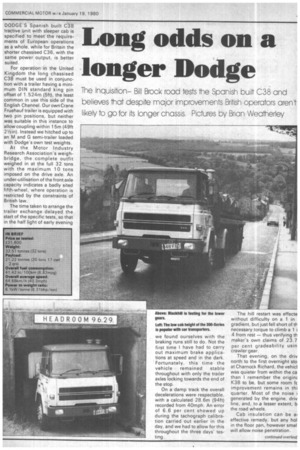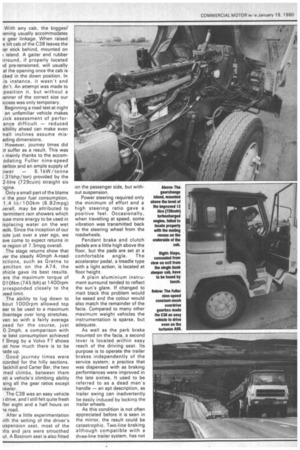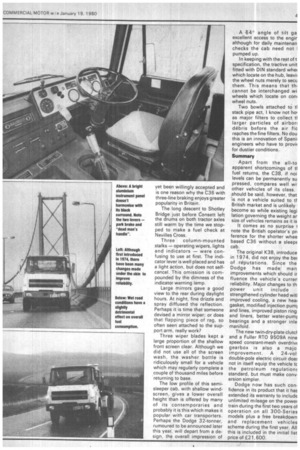Long odds on a longer Dodge
Page 43

Page 44

Page 45

If you've noticed an error in this article please click here to report it so we can fix it.
The Inc uisition-Bill Brock road tests the Spanish built C38 anc believes not despite major improvements British operators aren't likely to go for its longer chassis. Pictures by Brian Weatherley
DODGE'S Spanish built C38 tractive unit with sleeper cab is specified to meet the requirements of European operations as a whole, while for Britain the shorter chassised C36, with the same power output, is better suited.
For operation in the United Kingdom the long chassised C38 must be used in conjunction with a trailer having a minimum DIN standard king pin offset of 1.524m (5ft), the least common in use this side of the English Channel. Our own Crane Fruehauf trailer is equipped with two pin positions, but neither was suitable in this instance to allow coupling within 15m (49ft 21/2in). Instead we hitched up to an M and G semi-trailer loaded with Dodge's own test weights.
At the Motor Industry Research Association's weighbridge, the complete outfit weighed in at the full 32 tons with the maximum 10 tons imposed on the drive axle. An under-utilisation of the front axle capacity indicates a badly sited fifth-wheel, where operation is restricted by the constraints of British law.
The time taken to arrange the trailer exchange delayed the start of the specific tests, so that in the half light of early evening we found ourselves with the braking runs still to do. Not the first time I have had to carry out maximum brake applications at speed and in the dark. Fortunately, this time the vehicle remained stable throughout with only the trailer axles locking towards the end of the stop.
On a damp track the overall decelerations were respectable, with a calculated 28.6m (94ft) recorded from 40mph. An error of 6.6 per cent showed up during the tachograph calibration carried out earlier in the day, and we had to allow for this throughout the three days' testing. The hill restart was effecte without difficulty on a 1 in gradient, but just fell short of th necessary torque to climb a 1 i 4 from rest — thus verifying th maker's own claims of 23.7 per cent gradeability usin crawler gear.
That evening, on the driv north to the first overnight sto at Charnock Richard, the vehicl was quieter from within the ca than I remember the origin K38 to be, but some room fc improvement remains in thi quarter. Most of the noise i generated by the engine, driv line, and, to a lesser extent, b the road wheels.
Cab insulation can be ai effective remedy, but any hol in the floor pan, however smal will allow noise penetration. With any cab, the biggest' iening usually accommodates e gear linkage. When raised
e tilt cab of the C38 leaves the ar stick behind, mounted on island. A gaiter and rubber irrounci, if properly located id pre-tensioned, will usually al the opening once the cab is cked in the down position. In is instance, it wasn't and dn't. An attempt was made to ,position it, but without a ianner of the correct size our iccess was only temporary.
Beginning a road test at night an unfamiliar vehicle makes Jick assessment of perforance difficult — reduced sibility ahead can make even nail inclines assume misading dimensions.
However, journey times did yt suffer as a result. This was mainly thanks to the accorn°dating Fuller nine-speed aarbox and an ample supply of Dwer 6.1kW/tonne 1.31 bhp/ton) provided by the 2-litre (729cuin) straight six
Only a small part of the blame ir the poor fuel consumption, 1.4 lit/ 100krn (6.82mpg) verall, may be attributed to termittent rain showers which Rise more energy to be used in isplacing water on the wet 'ads. Since the inception of our iute just over a year ago, we ave come to expect returns in ie region of 7.5mpg overall. The stage returns show that ver the steady 40mph A-road• actions, such as Gretna to amilton on the A74, the ahicle gave its best results. ere the maximum torque of 010Nm (745.1bft) at 1400rprn Drresponded closely to the Deed limit.
The ability to lug down to bout 1000rpm allowed top ear to be used to a maximum clvantage over long stretches. ven so with a fairly average peed for the course, just 0.2mph, a comparison with le best consumption achieved f 8mpg by a Volvo F7 shows ist how much there is to be )ade up.
Good journey times were acorded for the hilly sections. lackhill and Carter Bar, the two med climbs, between them ast a vehicle's climbing ability sing all the gear ratios except rawler.
The C38 was an easy vehicle ) drive, and I still felt quite fresh (ter eight and a half hours on ie road.
After a little experimentation iith the setting of the driver's uspension seat, most of the ilts and jars were smoothed ut. A Bostrorn seat is also fitted on the passenger side, but without suspension.
Power steering required only the minimum of effort and a high steering ratio gave a positive feel. Occasionally, when travelling at speed, some vibration was transmitted back to the steering wheel from the roadwheels.
Pendant brake and clutch pedals are a little high above the floor, but the pads are set at a comfortable angle. The accelerator pedal, a treadle type with a light action, is located at floor height.
A plain aluminium instrument surround tended to reflect the sun's glare. If changed to matt black this problem would be eased and the colour would also match the remainder of the facia. Compared to many other. maximum weight vehicles the instrumentation is sparse, but adequate.
As well as the park brake mounted on the facia, a second lever is located within easy reach of the driving seat. Its purpose is to operate the trailer brakes independently of the service system; a practice that was dispensed with as braking performances were improved in the late sixties. It used to be referred to as a dead man's handle — an apt description, as trailer swing can inadvertently be easily induced by locking the trailer wheels.
As this condition is not often appreciated before it is seen in the mirror, the result could be catastrophic. Two-line braking although compatible with a three-line trailer system, has not yet been willingly accepted and is one reason why the C36 with three-line braking enjoys greater popularity in Britain.
The long descent to Shotley Bridge just before Consett left the drums on both tractor axles still warm by the time we stopped to make a fuel check at NeviIles Cross.
Three column-mounted stalks — operating wipers, lights and indicators — were confusing to use at first. The indicator lever is well placed and has a light action, but does not selfcancel. This omission is cornpounded by the dimness of the indicator warning lamp.
Large mirrors gave a good view to the rear during daylight hours. At night, fine drizzle and spray diffused the reflection. Perhaps it is time that someone devised a mirror wiper; or does that flapping piece of rag, so often seen attached to the support arm, really work?
Three wiper blades kept a large proportion of the shallow front screen clear. Although we did not use all of the screen wash, the washer bottle is ridiculously small for a vehicle which may regularly complete a .couple of thousand miles before returning to base.
The low profile of this semisleeper cab, with shallow windscreen, gives a lower overall height than is offered by many of its contemporaries and probably it is this which makes it popular with car transporters. Perhaps the Dodge 32-tonner, rumoured to be announced later this year, will depart from a design, the overall impression of A 64° angle of tilt ga excellent access to the engir although for daily maintenan checks the cab need not I pumped up.
In keeping with the rest of t specification, the tractive unit fitted with DIN standard whe( which locate on the hub, leavii the wheel nuts merely to secu them. This means that th, cannot be interchanged wi wheels which locate on con, wheel nuts.
Two bowls attached to tl stack pipe act, I know not hol as major filters to collect tl larger particles of airbori debris before the air flo reaches the fine filters. No dou this is an innovation of Spani: engineers who have to provic for dustier conditions.
Summary
Apart from the all-to apparent shortcomings of ti fuel returns, the 038, if noi levels can be permanently su pressed, compares well wi• other vehicles of its class. should be said, however, that is not a vehicle suited to th British market and is unlikely • become so while existing legi lation governing the weight ar size of vehicles remains as it is It comes as no surprise 1 note the British operator's pn ference for the shorter whee based C36 without a sleepE cab.
The original K38, introduce in 1974, did not enjoy the be of reputations. Since the Dodge has made man improvements which should ir fluence the vehicle's currer reliability. Major changes to th power unit include strengthened cylinder head witl improved cooling, a new heai gasket, modified injection pumj and lines, improved piston ring. and liners, better water-pumj bearings and a stronger inle manifold.
The new twin-dry-plate clutcl and a Fuller RTO 9509A nine speed constant-mesh overdriv( gearbox is also a majo improvement. A 24-vol double-pole electric circuit doe: not in itself equip the vehicle tc the petroleum regulations standard, but must make cony• ersion simpler.
Dodge now has such con• fidence in its product that it has. extended its warranty to include unlimited mileage on the power train during the first two years of operation on all 300-Series models plus a free breakdown and replacement vehicles scheme during the first year. All this is included in the initial list price of £21,600.












































































































